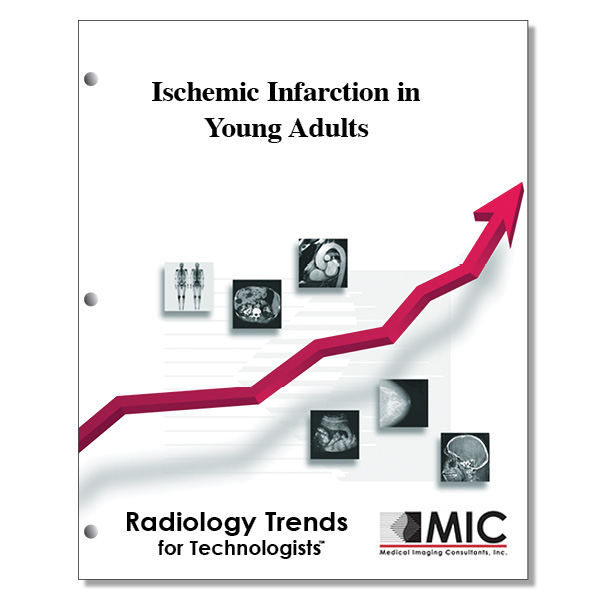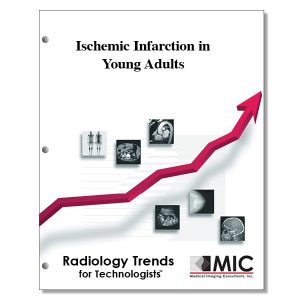

Ischemic Infarction in Young Adults
A review of the epidemiology, workup, and causes of ischemic infarction in young adults and how it differs from that in older adults.
Course ID: Q00628 Category: Radiology Trends for Technologists Modalities: CT, MRI, Vascular Interventional2.5 |
Satisfaction Guarantee |
$29.00
- Targeted CE
- Outline
- Objectives
Targeted CE per ARRT’s Discipline, Category, and Subcategory classification:
Computed Tomography: 2.50
Procedures: 2.50
Head, Spine, and Musculoskeletal: 2.50
Magnetic Resonance Imaging: 2.50
Procedures: 2.50
Neurological: 2.50
Registered Radiologist Assistant: 2.50
Procedures: 2.50
Neurological, Vascular, and Lymphatic Sections: 2.50
Vascular-Interventional Radiography: 2.50
Procedures: 2.50
Vascular Diagnostic Procedures: 2.50
Outline
- Introduction
- Epidemiology
- Clinical Approach
- Diagnosis
- Determining Cause
- Treatment
- Imaging
- CT versus MRI
- Cross-Sectional Angiography
- Perfusion Imaging
- Vessel Wall Imaging
- Catheter Angiography
- Causes
- Cardioembolic Stroke
- Septic Emboli
- Bland Emboli
- Atrial Myxoma
- Patent Foramen Ovale
- Dilated Cardiomyopathy and Atrial Fibrillation
- Intravascular Air Emboli
- Fat Emboli
- Other Demonstrated Causes
- Nonatherosclerotic Vasculopathies
- Dissection
- Carotid Web
- Reversible Cerebral Vasoconstriction Syndrome
- vasculitis
- Recreational Drug Use
- Cerebral Autosomal Dominant Arteriopathy with Dubcortical Infarcts and Leukoencephalopathy
- Moyamoya
- Prothrombic Disorders
- Factor V Leiden Mutation
- Antiphospholipid Syndrome
- Oral Contraceptive Use
- Pregnancy and Puerperium
- Nonatherosclerotic Vasculopathies
- Undetermined Cause
- Small-Vessel Occlusion
- Large-Artery Atherosclerosis
- Conclusion
Objectives
Upon completion of this course, students will:
- be familiar with the 5th leading cause of death in the United States
- identify the subtypes of ischemic infarction
- be familiar with the common stroke symptoms
- be familiar with the reference for quantifying the severity of a stroke
- identify the most common subtype of ischemic stroke in young adults
- be familiar with the catchphrase for acute stroke treatment
- understand the necessity for acquiring the LKWT
- identify the young adults with ischemic infarction that can benefit from revascularization
- be familiar with the advantages of using CT to assess acute ischemic stroke
- be familiar with the advantages of MRI to assess acute ischemic stroke
- be familiar with the perfusion parameters at CT perfusion imaging
- be familiar with vessel wall imaging techniques
- identify when catheter angiography is best suited for assessing stroke
- be familiar with TOAST
- identify a common cause of infectious endocarditis in young adults
- be familiar with common primary cardiac tumors in young adults
- be familiar with the percentage of adult patients with PFO
- identify the modality of choice when diagnosing PFO in young adults
- be familiar with the primary causes for cardioembolic infarcts
- be familiar with the presence of the MRI imaging pattern exhibited with a fat embolism
- identify the subcategories of the subtype Other Demonstrated Causes
- be familiar with vasculopathy
- identify the imaging modalities of choice when diagnosing a carotid dissection
- be familiar with the diagnostic criteria for RCVS
- identify the drug for treating RCVS
- be familiar with the defect associated with a carotid web
- be familiar with the routine workup for RCVS
- identify an illicit drug that can lead to a catastrophic ischemic injury
- be familiar with CADASIL
- be familiar with the causes of moyamoya
- be familiar with the percentage of moyamoya patients experiencing a cerebral infarction
- be familiar with factor V Leiden mutation and its relationship with ischemic infarction
- be familiar with the prothrombotic disorder of antiphospholipid syndrome
- be familiar with the risk of cerebral venous thrombosis during puerperium
- identify the patient risk factors associated with small-vessel occlusion
